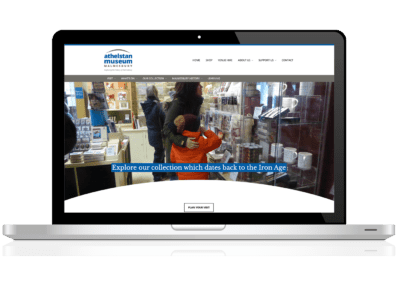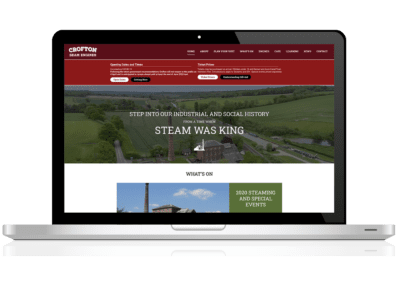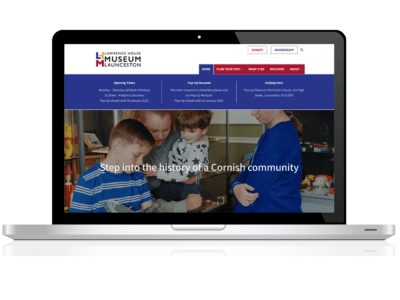The purpose of a charity website is to inform and educate people about the mission and work of the charity, as well as to engage and motivate them to support your cause. Your website should aim to support your cause by:
- Raising awareness
- Fundraising
- Recruiting volunteers
- Providing information
- Building relationships
In this article, we will explore ten ways in which you can address the information you share on your charity website to achieve these goals.
1. A clear and concise mission statement

A mission statement is a crucial element for you to communicate your purpose and values to your stakeholders and should be prominently displayed on your website. Writing a clear, concise, and memorable mission statement is essential to ensure that your message is easily understood and resonates with your intended audience.
Regularly review your mission statement to ensure that it remains relevant and aligned with your goals and values. As your charity evolves and grows, the mission statement may need to be revised to reflect any changes in direction or focus.
2. Clear calls-to-action
Creating a clear call-to-action is essential if you want to attract visitors to get involved and take specific actions such as making a donation, signing up for a newsletter, or volunteering.
A call-to-action should be prominently displayed, and use direct language that clearly states what action you want the visitor to take. For example, “Donate Now” or “Volunteer Today”. Consider using contrasting colours and bold text to make it stand out.
The call-to-action should create a sense of urgency that motivates the visitor. This can be done by highlighting the immediate impact of their involvement, or by providing a deadline. Your message should also be specific about what the visitor will achieve by taking action, for example, “Join our community of volunteers and make a difference to the lives of those in need.”
Ensure the call-to-action is easy to understand and simple to complete. Visitors should not have to navigate through multiple pages or fill out a lengthy form to take action.
Finally, you should consider regularly testing and refining your calls-to-action to ensure that they are effective in attracting visitors.
3. Donation information

Ideally, your website should make it easy and convenient for donors to give both online and offline. It is also worth considering how you will track progress and recognise any significant contributions.
Some of the best methods where donations can be collected via your website include:
- Simple Button or Link: The quickest and easiest method is to include a simple button/link to a third-party fundraising platform like JustGiving and Donr (running an active campaign or charity page). Keep in mind that most fundraising platforms charge a small processing fee but do allow eligible taxpayers to include Gift Aid as part of their donation.
- Charity Banking Platform: If you want to collect donations directly with no processing fee, then it is worth considering switching to a bank that specialises in charities. The Charities Aid Foundation (CAF Bank) is a bank specifically for charities. The CAF banking platform includes a customisable donation page that will take payments directly into your charity’s bank account. A minor downside to this method is that the user is redirected away from your website to the banking platform in order to make a donation.
- Form and Payment Gateway Integration: Another method is to create an online donation form on your charity website allowing donors to give directly via credit card or PayPal. The form should be secure and user-friendly, with clear instructions and a prominent call-to-action. Your donations will need to be processed via a reliable third-party payment gateway provider e.g., Stripe or PayPal. Payment gateways provide you with secure processing for credit and debit card transactions and give donors peace of mind knowing that their information is safe. Like fundraising platforms payment gateway providers also charge a small fee however, many offer a discounted rate to registered charities.
- Mobile Text Giving: Consider using mobile giving to allow donors to give via text message. This can be a convenient option for those who prefer to give on-the-go. Some fundraising providers like Donr offer a suite of pick-and-mix solutions that include online donation pages as well as text giving.
- Integration with Customer Relationship Management (CRM) Technology: If you are looking for a solution that will allow you to collect donations, track progress, and manage donor relationships then you might want to consider using a CRM system. A simple online search will yield a huge variety of CRM providers, many of which specialise in charity solutions. It is worth noting that CRM systems are not a cheap option and that implementation and ongoing fees can be costly. If you are considering a CRM system, then start with a list of your minimum requirements i.e. collecting donations and managing donor relationships. Use a spreadsheet to compare costs and user benefits. Once you have a shortlist, ask the CRM providers for a demonstration and a free two-week test drive of the system. Other things worth noting include; customisations your charity may need, the length of time it takes to implement and embed the system, integration with your existing website, and staff training requirements.
- Donation Thermometer: Use a donation thermometer on your website to track progress toward your fundraising goals. This can motivate donors to give and help create a sense of urgency.
- Offline Donations: Provide clear instructions on your website for how to give offline, including downloads and options for mailing a cheque or making a donation in-person at a local post office or event.
- Donor Recognition: Recognise and thank donors for significant contributions by prominently displaying donor names or offering incentives such as exclusive content or events.
- Social Media: Use social media to promote your charity’s fundraising campaigns and encourage donations. Share updates and success stories to engage your audience and build excitement.
- Corporate Giving: Consider partnering with corporations for donation matching or other giving programmes such as Pay As You Earn (PAYE). Feature these partnerships prominently on your website to encourage support from both individuals and businesses.
4. Information about your programmes
Providing information about your charity’s programmes and services is an important part of communicating your mission and impact.
Transparency and accountability to donors, stakeholders, and the public can be demonstrated through the communication of your services helping to build trust and credibility. Consider sharing success stories, case studies, and other examples of your charity’s work to communicate the impact your programmes and services are having. This will allow donors to see tangible results of their support which can encourage them to continue giving.
Providing information about your programmes and services can also help with volunteer and staff recruitment. People who are interested in volunteering or working for your charity will want to know what programmes and services are offered, and how they can get involved.
5. Photos and rich media
Photos and rich media are powerful tools for capturing attention, conveying emotion, telling stories, and creating a consistent and recognisable brand identity. By using them effectively on your charity website you can increase engagement with your audience and inspire support.
Photos and rich media such as videos and animations are eye-catching and can quickly capture the attention of the viewer. A compelling photo or video can convey emotion in a way that text alone cannot. They can help to illustrate the impact of your charity’s work and evoke feelings of empathy, compassion, and hope.
Photos and rich media on your website are more likely to be shared and can lead to increased awareness, reach, and exposure.
6. Social media links
Including links to your social media accounts on your charity website can help expand your reach, enhance communication, build community, drive fundraising and advocacy efforts, and reinforce your charity’s brand identity.
Social media platforms provide a convenient and accessible way to communicate with your audience in real-time. They allow for interactive engagement where supporters can share, like, comment, and tag your charity’s content, as well as connect with each other. This can create a sense of belonging and encourage supporters to become more actively involved in your charity’s efforts.
You can use social media to promote fundraising campaigns, share success stories, and encourage supporters to act, such as signing petitions or spreading awareness.
7. Contact information
Including accurate and up-to-date contact information on your charity website is crucial for building trust, establishing credibility, and facilitating communication with supporters, donors, and other stakeholders.
As a minimum, you should provide an email address for general enquiries or specific purposes e.g., donations, volunteering, or membership. It’s important to regularly monitor and respond to emails received to ensure timely and effective communication.
A contact form will allow visitors to send questions or messages directly to the charity. The contact form should be simple and easy to find, collecting only relevant information such as the sender’s name, email address, and message. Using a reCAPTCHA on the form can help reduce unwanted spam messages getting through to your inbox.
Include a phone number to allow visitors to make direct phone enquiries or contact your charity for urgent matters. It’s important to ensure that the phone number is correct and that someone from your charity is available to answer calls or return voicemails in a timely manner.
Provide a physical mailing address for donors or stakeholders who prefer to communicate by mail or need to send physical documents. It also adds credibility by demonstrating a physical presence.
Ideally, you should display your basic contact information (email address and phone number) in the footer section of every page. A specific contact page should be used to share your physical address, names of contacts, and a contact form.
8. Transparency information
Transparency is a key aspect of your operations and sharing relevant information on your website can help build trust with your charity stakeholders. As a minimum requirement, you should publish the following organisational information:
- Name and address of your registered charity
- The part of the UK in which the charity is registered (i.e. England and Wales, Scotland, etc)
- Registered charity number(s)
Ideally, this information should appear in the footer of every page as well as your contact page.
Share information on your website about your charity’s governance structure, including the board of directors or trustees, leadership team, and organisational policies.
Publish your annual report and breakdowns of how funds are used. Include information on the charity’s sources of income such as donations, grants, and other funding to help provide transparency about your financial sustainability.
Make information about your donor privacy policy easily accessible and include how you are processing and protecting donor data. Share how donor information is stored, who has access to it, and how it is used for fundraising and marketing purposes. It’s important to provide clear information about donor consent options and allow donors to easily opt-in or opt-out of receiving communications from your charity.
Consider publishing your reporting and evaluation processes, including how performance and impact are measured. A clear and concise strategic plan can help demonstrate your charity’s commitment to learning, improvement, and transparency. This may include information about evaluation methods, reporting frequency, and how results are used to inform decision-making and programme improvements.
9. Testimonials
Testimonials are a form of social proof and can create an emotional connection with your audience by telling real stories of how the charity has made a difference in people’s lives. They provide evidence of the beneficiaries who have received support from your charity’s programmes and services, showcasing the impact of your work. Seeing positive feedback is inspiring and can help potential donors and supporters feel more confident in their decision to support your charity and feel more personally invested in your mission and programmes.
It’s important to ensure that your testimonials are genuine, relevant, and respectful of privacy. You should ensure that you have the consent of the individuals involved and that it complies with relevant laws and regulations.
10. News and updates

Sharing news and updates on your charity website is important for:
- Transparency
- Engagement
- Trust-building
- Promoting achievements and impact
- Encouraging action
- Enhancing your online presence and boosting your SEO
It helps keep stakeholders informed and engaged and contributes to building a positive and credible image for your charity. Regular updates show that the charity is actively engaged in its mission, progress, challenges, and achievements.
It is worth doing the occasional spring clean of your news because outdated or irrelevant content can harm your search engine ranking and your visitors’ experience of your website.
Charities we have partnered with
Are you a charity looking to make a difference in the world?
Let us be your partner in creating a stunning website that tells your story and inspires action. With our expertise in web design and development, we can create a custom website that not only looks great but also delivers a seamless user experience, making it easy for visitors to understand your mission and support your cause. Contact us now to get started!






 Using a Table Block in a Block Template
Using a Table Block in a Block Template
Leave a Reply